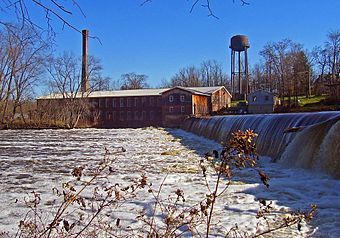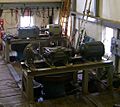Montgomery Worsted Mills facts for kids
Quick facts for kids |
|
|
Montgomery Worsted Mills
|
|

The mills and its dam from across the Wallkill River
|
|
| Location | 23 Factory Street, Montgomery, New York |
|---|---|
| Nearest city | Newburgh |
| Built | 1813, rebuilt 1892 |
| NRHP reference No. | 80002738 |
| Added to NRHP | November 21, 1980 |
The Montgomery Worsted Mills, now called Montgomery Mills, is located next to the Wallkill River in the village of Montgomery, New York. It was one of the first places to use the river's power for factories.
The people who started the mills, Arthur Patchett and William Crabtree, became very successful. They made a big difference in their community. Many of the houses on Factory Street were built by them for their families. Their descendants still live in the Montgomery area today. The mills are still working, but they are no longer owned by the family. They also don't make fabric anymore. While they do sell yarn, the mill mostly makes electric power now. There's also a plan to turn it into a City Winery.
What the Mills Look Like Today
The mills today have a main brick building that runs from north to south along the river. There's also an east-west part of the building. This part is three stories high and built partly over the nearby dam and its flume (a channel for water). This is where the hydroelectric turbines are, which make electricity from water. Another east-west part of the building holds the main office and a store.
A second brick building, located a bit uphill, is currently rented out. A company that makes decorative parts for buildings uses it. One barn, which was the second one built, is a little further down the river in some nearby woods. Factory Street turns into a gravel loop at the mill. In the past, there were two large apartment buildings for mill workers on the uphill side of the property. However, they were torn down many years ago.
History of Montgomery Mills
The river has had a dam at this spot since at least the 1700s. A grist mill (for grinding grain) was already across the river when Johannes Miller started looking for investors in 1813. He wanted to build a cotton mill. This was one of the first times people tried to use the Wallkill River for factories. Back then, wool came straight from local sheep. It was completely processed (cleaned and spun) right at the mill.
The cotton mill didn't even start making things. Nothing happened at the site until about 1870. That's when an English immigrant named Edmund Ackroyd bought the property. He added a three-story part to the building. Ten years later, William Crabtree and Arthur Patchett bought the mills. They focused on making yarn (spinning) instead of weaving fabric. In 1897, they had to open another factory in Newburgh. This was because they couldn't find enough workers in Montgomery.
On Election Day, November 3, 1891, the factory burned down completely. The building you see today, which is 50,000 square feet, was built in its place. It was ready to operate by the next summer. Another fire destroyed the Newburgh factory on May 23, 1900.
Patchett died in late 1901. The next year, Crabtree made his five sons his business partners. He then died himself a year later while returning to England. All the sons built houses on the hillside above the mill. Some of these houses are still standing. They were later used to house employees.
In 1906, they made the mill even bigger. They extended the south part to add more space for making yarn. The office that had been there was moved to a new north part. This new section also had rooms for sorting, cleaning, and preparing wool. Eight years later, the dam was rebuilt so it went straight across the river. After World War I, the mill grew a lot. Sometime before the mid-1920s, the Wallkill Valley Railroad built tracks that crossed Factory Street near the mill. This made it much easier to ship finished yarns by train. Cars also started replacing the horse-drawn carts that had been carrying the finished product.
A new packing and sorting part was built in 1922. A new factory was also bought in Newburgh. However, these new parts couldn't help the business survive the Great Depression. The mills were sold to the Steinberger family from New York. They've owned it and kept it running in some way ever since.
In the late 1940s, the old houses where the workers lived were torn down. They cost too much to keep up. The Steinbergers slowly changed the mill to focus on making electricity. Today, they sell 250 kilowatts of hydroelectric power to CH Energy Group. They also rent out some parts of the building and offer shipping services. A shop in the mill is open to the public every day from 9 a.m. to 4 p.m. It sells yarns for knitting and weaving.
The Steinbergers agreed to sell the mill to Michael Dorf in 2018. If he buys it and the village agrees, he wants to turn the building into a City Winery. He might add some hotel space too. It would be the only City Winery that would make wine right there. It could make 30,000-40,000 cases a year, using power from the river and solar panels on the roof.
Images for kids



